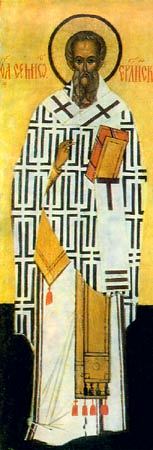Simeon of Jerusalem
| Saint Simeon | |
|---|---|
 |
|
| Bishop and Martyr | |
| Born | Galilee, Judaea Province |
| Died | c. 107 or 117 AD Jerusalem, Iudaea Province |
| Venerated in |
Roman Catholic Church Eastern Orthodox Church Lutheran Church |
| Canonized | Pre-Congregation |
| Feast | February 18 (Western Christianity) April 27 (Eastern Christianity) |
Saint Simeon of Jerusalem, son of Clopas, was a Jewish Christian leader and according to most Christian traditions the second Bishop of Jerusalem (62 or 70–107).
Eusebius of Caesarea gives the list of these bishops. According to a universal tradition the first bishop of Jerusalem was Saint James the Just, the "brother of the Lord," who according to Eusebius said that he was appointed bishop by the Apostles Peter, St. James (whom Eusebius identifies with James, son of Zebedee), and John.
According to Eusebius, Saint Simeon of Jerusalem was selected as James' successor after the conquest of Jerusalem which took place immediately after the martyrdom of James (i.e. no earlier than 70 AD) which puts the account in conflict with that of Flavius Josephus who puts James death in 63 AD:
After the martyrdom of James and the conquest of Jerusalem which immediately followed, it is said that those of the apostles and disciples of the Lord that were still living came together from all directions with those that were related to the Lord according to the flesh (for the majority of them also were still alive) to take counsel as to who was worthy to succeed James. They all with one consent pronounced Symeon, the son of Clopas, of whom the Gospel also makes mention; to be worthy of the episcopal throne of that parish. He was a cousin, as they say, of the Saviour. For Hegesippus records that Clopas was a brother of Joseph.
According to Hegesippus, Simeon prevailed against Thebutis, whom the church fathers deemed a Judaizing heresiarch, and led most of the Christians to Pella before the outbreak of the Jewish War in 66 and the destruction of Herod's Temple in 70.
About the year 107 or 117 he was crucified under Trajan by the proconsul Tiberius Claudius Atticus Herodes in Jerusalem or the vicinity. However,this must be a mistake because the Roman province of Judea the Roman administrator (Legate) of the day at the time of the crucifixion was a Quintus Pompeius Falco (between 105-107 AD) and Tiberius Claudius Atticus Herodes was there much earlier from 99-102 AD.
...
Wikipedia
